Brand Perception: Factors, Theories, and Impact - Literature Review
VerifiedAdded on 2022/08/19
|10
|2886
|15
Literature Review
AI Summary
This literature review delves into the multifaceted concept of brand perception, examining its core components, influencing factors, and implications for customer behavior and business strategy. It defines brand perception as the outcome of customer interactions, experiences, and relationships with a brand, influenced by tools such as reviews, sales interactions, and marketing. The review explores theories of brand perception, including brand experience, brand trust, and brand affect, and how they shape customer loyalty and purchasing decisions. Factors affecting brand perception are analyzed, including product pricing, quality, customer service, marketing strategies, and brand reputation. The impact of geographical origin on brand perception is also discussed. The review emphasizes the role of positive brand perception in fostering strong customer relationships, increasing market share, and gaining a competitive advantage, while highlighting the potential negative consequences of poor brand perception. The review draws on multiple sources and offers insights into the complex dynamics of brand perception and its impact on business outcomes.
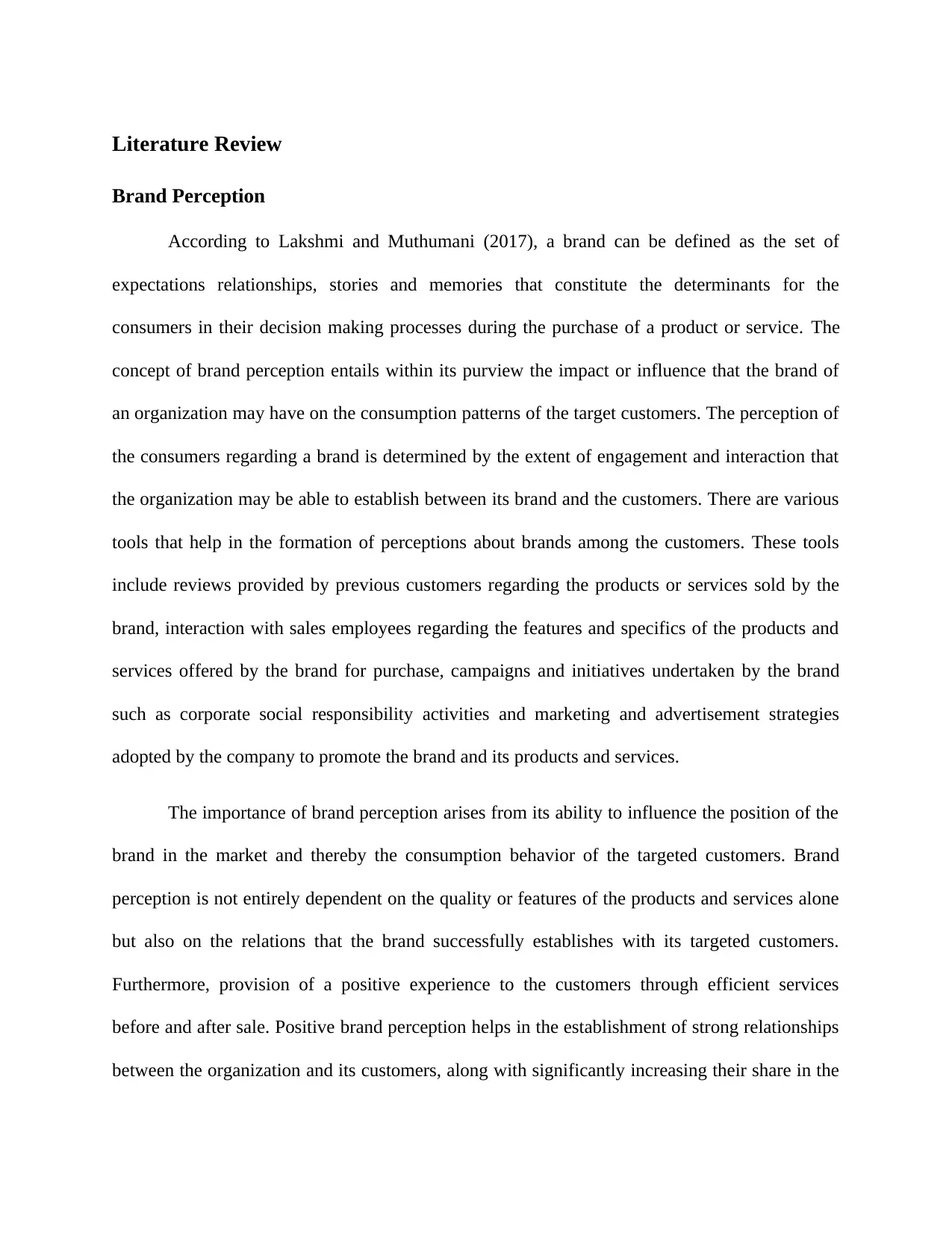
Literature Review
Brand Perception
According to Lakshmi and Muthumani (2017), a brand can be defined as the set of
expectations relationships, stories and memories that constitute the determinants for the
consumers in their decision making processes during the purchase of a product or service. The
concept of brand perception entails within its purview the impact or influence that the brand of
an organization may have on the consumption patterns of the target customers. The perception of
the consumers regarding a brand is determined by the extent of engagement and interaction that
the organization may be able to establish between its brand and the customers. There are various
tools that help in the formation of perceptions about brands among the customers. These tools
include reviews provided by previous customers regarding the products or services sold by the
brand, interaction with sales employees regarding the features and specifics of the products and
services offered by the brand for purchase, campaigns and initiatives undertaken by the brand
such as corporate social responsibility activities and marketing and advertisement strategies
adopted by the company to promote the brand and its products and services.
The importance of brand perception arises from its ability to influence the position of the
brand in the market and thereby the consumption behavior of the targeted customers. Brand
perception is not entirely dependent on the quality or features of the products and services alone
but also on the relations that the brand successfully establishes with its targeted customers.
Furthermore, provision of a positive experience to the customers through efficient services
before and after sale. Positive brand perception helps in the establishment of strong relationships
between the organization and its customers, along with significantly increasing their share in the
Brand Perception
According to Lakshmi and Muthumani (2017), a brand can be defined as the set of
expectations relationships, stories and memories that constitute the determinants for the
consumers in their decision making processes during the purchase of a product or service. The
concept of brand perception entails within its purview the impact or influence that the brand of
an organization may have on the consumption patterns of the target customers. The perception of
the consumers regarding a brand is determined by the extent of engagement and interaction that
the organization may be able to establish between its brand and the customers. There are various
tools that help in the formation of perceptions about brands among the customers. These tools
include reviews provided by previous customers regarding the products or services sold by the
brand, interaction with sales employees regarding the features and specifics of the products and
services offered by the brand for purchase, campaigns and initiatives undertaken by the brand
such as corporate social responsibility activities and marketing and advertisement strategies
adopted by the company to promote the brand and its products and services.
The importance of brand perception arises from its ability to influence the position of the
brand in the market and thereby the consumption behavior of the targeted customers. Brand
perception is not entirely dependent on the quality or features of the products and services alone
but also on the relations that the brand successfully establishes with its targeted customers.
Furthermore, provision of a positive experience to the customers through efficient services
before and after sale. Positive brand perception helps in the establishment of strong relationships
between the organization and its customers, along with significantly increasing their share in the
Paraphrase This Document
Need a fresh take? Get an instant paraphrase of this document with our AI Paraphraser
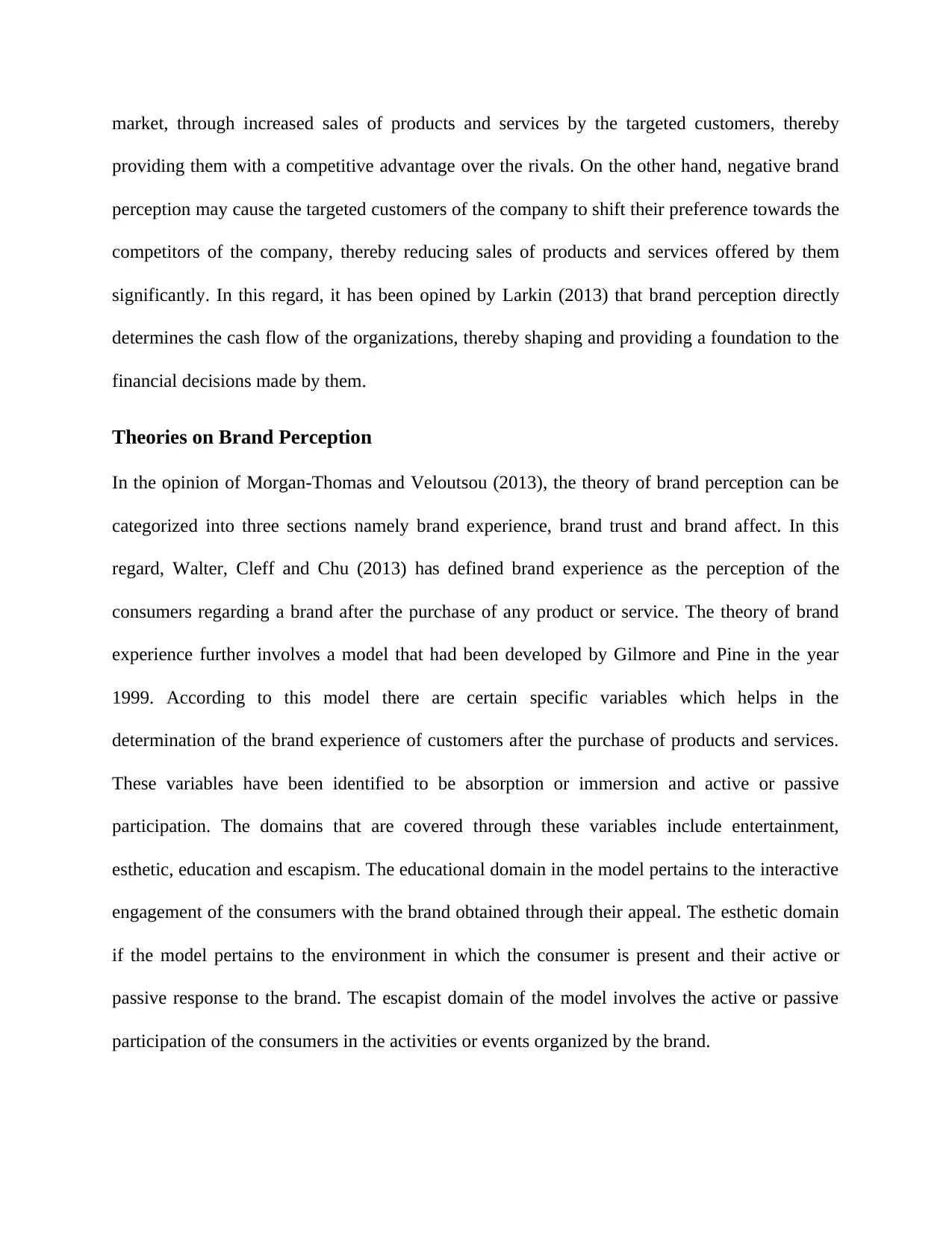
market, through increased sales of products and services by the targeted customers, thereby
providing them with a competitive advantage over the rivals. On the other hand, negative brand
perception may cause the targeted customers of the company to shift their preference towards the
competitors of the company, thereby reducing sales of products and services offered by them
significantly. In this regard, it has been opined by Larkin (2013) that brand perception directly
determines the cash flow of the organizations, thereby shaping and providing a foundation to the
financial decisions made by them.
Theories on Brand Perception
In the opinion of Morgan-Thomas and Veloutsou (2013), the theory of brand perception can be
categorized into three sections namely brand experience, brand trust and brand affect. In this
regard, Walter, Cleff and Chu (2013) has defined brand experience as the perception of the
consumers regarding a brand after the purchase of any product or service. The theory of brand
experience further involves a model that had been developed by Gilmore and Pine in the year
1999. According to this model there are certain specific variables which helps in the
determination of the brand experience of customers after the purchase of products and services.
These variables have been identified to be absorption or immersion and active or passive
participation. The domains that are covered through these variables include entertainment,
esthetic, education and escapism. The educational domain in the model pertains to the interactive
engagement of the consumers with the brand obtained through their appeal. The esthetic domain
if the model pertains to the environment in which the consumer is present and their active or
passive response to the brand. The escapist domain of the model involves the active or passive
participation of the consumers in the activities or events organized by the brand.
providing them with a competitive advantage over the rivals. On the other hand, negative brand
perception may cause the targeted customers of the company to shift their preference towards the
competitors of the company, thereby reducing sales of products and services offered by them
significantly. In this regard, it has been opined by Larkin (2013) that brand perception directly
determines the cash flow of the organizations, thereby shaping and providing a foundation to the
financial decisions made by them.
Theories on Brand Perception
In the opinion of Morgan-Thomas and Veloutsou (2013), the theory of brand perception can be
categorized into three sections namely brand experience, brand trust and brand affect. In this
regard, Walter, Cleff and Chu (2013) has defined brand experience as the perception of the
consumers regarding a brand after the purchase of any product or service. The theory of brand
experience further involves a model that had been developed by Gilmore and Pine in the year
1999. According to this model there are certain specific variables which helps in the
determination of the brand experience of customers after the purchase of products and services.
These variables have been identified to be absorption or immersion and active or passive
participation. The domains that are covered through these variables include entertainment,
esthetic, education and escapism. The educational domain in the model pertains to the interactive
engagement of the consumers with the brand obtained through their appeal. The esthetic domain
if the model pertains to the environment in which the consumer is present and their active or
passive response to the brand. The escapist domain of the model involves the active or passive
participation of the consumers in the activities or events organized by the brand.
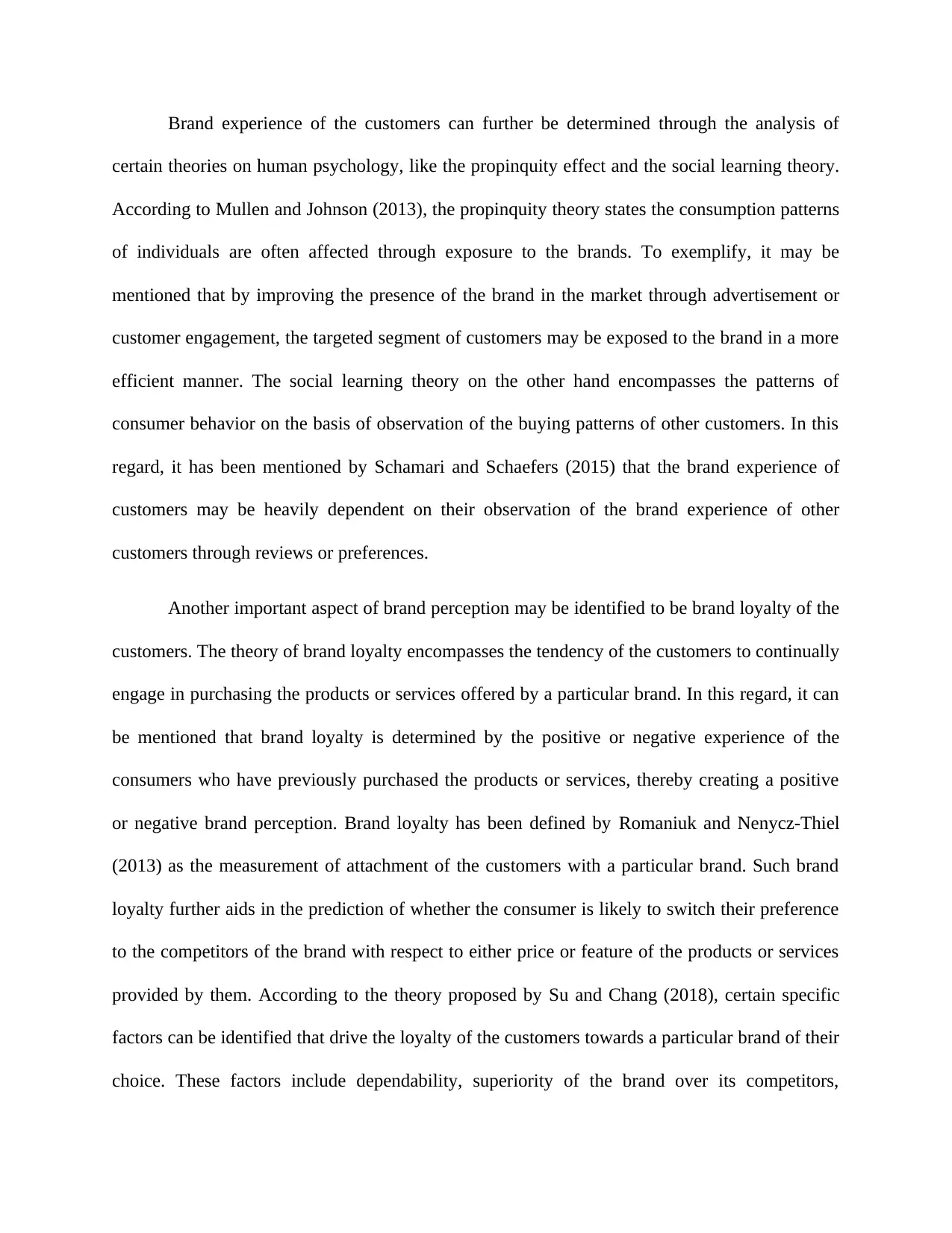
Brand experience of the customers can further be determined through the analysis of
certain theories on human psychology, like the propinquity effect and the social learning theory.
According to Mullen and Johnson (2013), the propinquity theory states the consumption patterns
of individuals are often affected through exposure to the brands. To exemplify, it may be
mentioned that by improving the presence of the brand in the market through advertisement or
customer engagement, the targeted segment of customers may be exposed to the brand in a more
efficient manner. The social learning theory on the other hand encompasses the patterns of
consumer behavior on the basis of observation of the buying patterns of other customers. In this
regard, it has been mentioned by Schamari and Schaefers (2015) that the brand experience of
customers may be heavily dependent on their observation of the brand experience of other
customers through reviews or preferences.
Another important aspect of brand perception may be identified to be brand loyalty of the
customers. The theory of brand loyalty encompasses the tendency of the customers to continually
engage in purchasing the products or services offered by a particular brand. In this regard, it can
be mentioned that brand loyalty is determined by the positive or negative experience of the
consumers who have previously purchased the products or services, thereby creating a positive
or negative brand perception. Brand loyalty has been defined by Romaniuk and Nenycz-Thiel
(2013) as the measurement of attachment of the customers with a particular brand. Such brand
loyalty further aids in the prediction of whether the consumer is likely to switch their preference
to the competitors of the brand with respect to either price or feature of the products or services
provided by them. According to the theory proposed by Su and Chang (2018), certain specific
factors can be identified that drive the loyalty of the customers towards a particular brand of their
choice. These factors include dependability, superiority of the brand over its competitors,
certain theories on human psychology, like the propinquity effect and the social learning theory.
According to Mullen and Johnson (2013), the propinquity theory states the consumption patterns
of individuals are often affected through exposure to the brands. To exemplify, it may be
mentioned that by improving the presence of the brand in the market through advertisement or
customer engagement, the targeted segment of customers may be exposed to the brand in a more
efficient manner. The social learning theory on the other hand encompasses the patterns of
consumer behavior on the basis of observation of the buying patterns of other customers. In this
regard, it has been mentioned by Schamari and Schaefers (2015) that the brand experience of
customers may be heavily dependent on their observation of the brand experience of other
customers through reviews or preferences.
Another important aspect of brand perception may be identified to be brand loyalty of the
customers. The theory of brand loyalty encompasses the tendency of the customers to continually
engage in purchasing the products or services offered by a particular brand. In this regard, it can
be mentioned that brand loyalty is determined by the positive or negative experience of the
consumers who have previously purchased the products or services, thereby creating a positive
or negative brand perception. Brand loyalty has been defined by Romaniuk and Nenycz-Thiel
(2013) as the measurement of attachment of the customers with a particular brand. Such brand
loyalty further aids in the prediction of whether the consumer is likely to switch their preference
to the competitors of the brand with respect to either price or feature of the products or services
provided by them. According to the theory proposed by Su and Chang (2018), certain specific
factors can be identified that drive the loyalty of the customers towards a particular brand of their
choice. These factors include dependability, superiority of the brand over its competitors,
⊘ This is a preview!⊘
Do you want full access?
Subscribe today to unlock all pages.

Trusted by 1+ million students worldwide
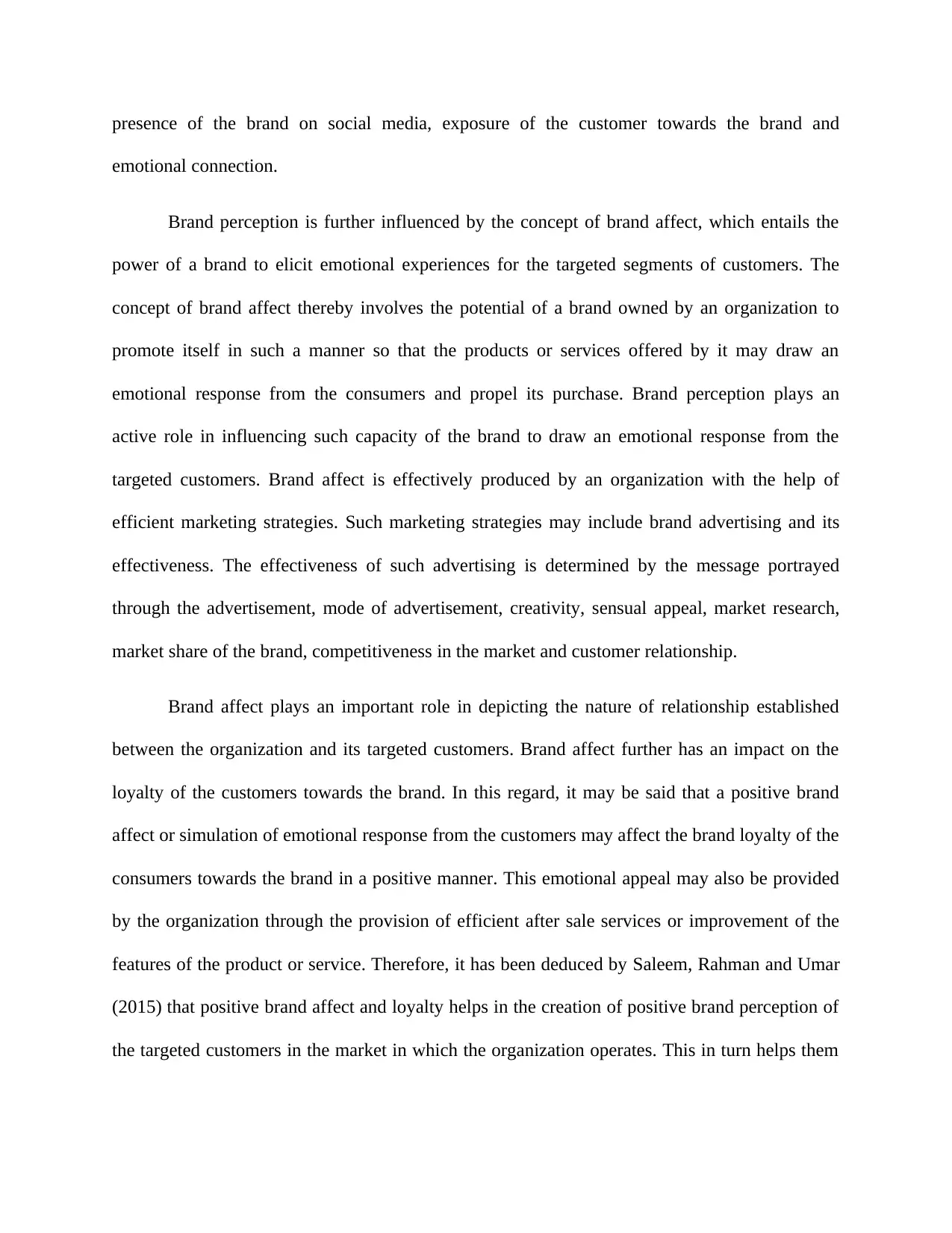
presence of the brand on social media, exposure of the customer towards the brand and
emotional connection.
Brand perception is further influenced by the concept of brand affect, which entails the
power of a brand to elicit emotional experiences for the targeted segments of customers. The
concept of brand affect thereby involves the potential of a brand owned by an organization to
promote itself in such a manner so that the products or services offered by it may draw an
emotional response from the consumers and propel its purchase. Brand perception plays an
active role in influencing such capacity of the brand to draw an emotional response from the
targeted customers. Brand affect is effectively produced by an organization with the help of
efficient marketing strategies. Such marketing strategies may include brand advertising and its
effectiveness. The effectiveness of such advertising is determined by the message portrayed
through the advertisement, mode of advertisement, creativity, sensual appeal, market research,
market share of the brand, competitiveness in the market and customer relationship.
Brand affect plays an important role in depicting the nature of relationship established
between the organization and its targeted customers. Brand affect further has an impact on the
loyalty of the customers towards the brand. In this regard, it may be said that a positive brand
affect or simulation of emotional response from the customers may affect the brand loyalty of the
consumers towards the brand in a positive manner. This emotional appeal may also be provided
by the organization through the provision of efficient after sale services or improvement of the
features of the product or service. Therefore, it has been deduced by Saleem, Rahman and Umar
(2015) that positive brand affect and loyalty helps in the creation of positive brand perception of
the targeted customers in the market in which the organization operates. This in turn helps them
emotional connection.
Brand perception is further influenced by the concept of brand affect, which entails the
power of a brand to elicit emotional experiences for the targeted segments of customers. The
concept of brand affect thereby involves the potential of a brand owned by an organization to
promote itself in such a manner so that the products or services offered by it may draw an
emotional response from the consumers and propel its purchase. Brand perception plays an
active role in influencing such capacity of the brand to draw an emotional response from the
targeted customers. Brand affect is effectively produced by an organization with the help of
efficient marketing strategies. Such marketing strategies may include brand advertising and its
effectiveness. The effectiveness of such advertising is determined by the message portrayed
through the advertisement, mode of advertisement, creativity, sensual appeal, market research,
market share of the brand, competitiveness in the market and customer relationship.
Brand affect plays an important role in depicting the nature of relationship established
between the organization and its targeted customers. Brand affect further has an impact on the
loyalty of the customers towards the brand. In this regard, it may be said that a positive brand
affect or simulation of emotional response from the customers may affect the brand loyalty of the
consumers towards the brand in a positive manner. This emotional appeal may also be provided
by the organization through the provision of efficient after sale services or improvement of the
features of the product or service. Therefore, it has been deduced by Saleem, Rahman and Umar
(2015) that positive brand affect and loyalty helps in the creation of positive brand perception of
the targeted customers in the market in which the organization operates. This in turn helps them
Paraphrase This Document
Need a fresh take? Get an instant paraphrase of this document with our AI Paraphraser
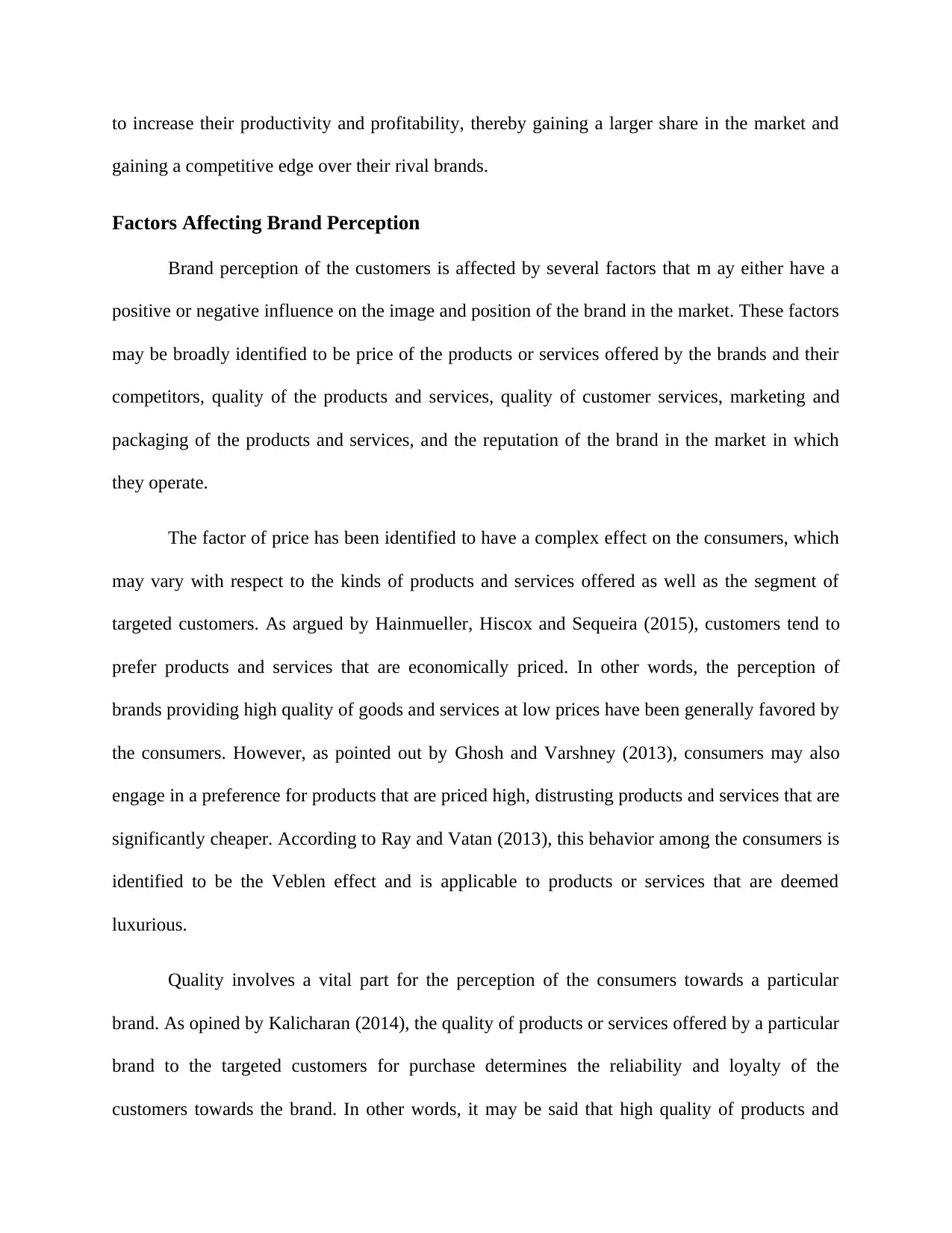
to increase their productivity and profitability, thereby gaining a larger share in the market and
gaining a competitive edge over their rival brands.
Factors Affecting Brand Perception
Brand perception of the customers is affected by several factors that m ay either have a
positive or negative influence on the image and position of the brand in the market. These factors
may be broadly identified to be price of the products or services offered by the brands and their
competitors, quality of the products and services, quality of customer services, marketing and
packaging of the products and services, and the reputation of the brand in the market in which
they operate.
The factor of price has been identified to have a complex effect on the consumers, which
may vary with respect to the kinds of products and services offered as well as the segment of
targeted customers. As argued by Hainmueller, Hiscox and Sequeira (2015), customers tend to
prefer products and services that are economically priced. In other words, the perception of
brands providing high quality of goods and services at low prices have been generally favored by
the consumers. However, as pointed out by Ghosh and Varshney (2013), consumers may also
engage in a preference for products that are priced high, distrusting products and services that are
significantly cheaper. According to Ray and Vatan (2013), this behavior among the consumers is
identified to be the Veblen effect and is applicable to products or services that are deemed
luxurious.
Quality involves a vital part for the perception of the consumers towards a particular
brand. As opined by Kalicharan (2014), the quality of products or services offered by a particular
brand to the targeted customers for purchase determines the reliability and loyalty of the
customers towards the brand. In other words, it may be said that high quality of products and
gaining a competitive edge over their rival brands.
Factors Affecting Brand Perception
Brand perception of the customers is affected by several factors that m ay either have a
positive or negative influence on the image and position of the brand in the market. These factors
may be broadly identified to be price of the products or services offered by the brands and their
competitors, quality of the products and services, quality of customer services, marketing and
packaging of the products and services, and the reputation of the brand in the market in which
they operate.
The factor of price has been identified to have a complex effect on the consumers, which
may vary with respect to the kinds of products and services offered as well as the segment of
targeted customers. As argued by Hainmueller, Hiscox and Sequeira (2015), customers tend to
prefer products and services that are economically priced. In other words, the perception of
brands providing high quality of goods and services at low prices have been generally favored by
the consumers. However, as pointed out by Ghosh and Varshney (2013), consumers may also
engage in a preference for products that are priced high, distrusting products and services that are
significantly cheaper. According to Ray and Vatan (2013), this behavior among the consumers is
identified to be the Veblen effect and is applicable to products or services that are deemed
luxurious.
Quality involves a vital part for the perception of the consumers towards a particular
brand. As opined by Kalicharan (2014), the quality of products or services offered by a particular
brand to the targeted customers for purchase determines the reliability and loyalty of the
customers towards the brand. In other words, it may be said that high quality of products and
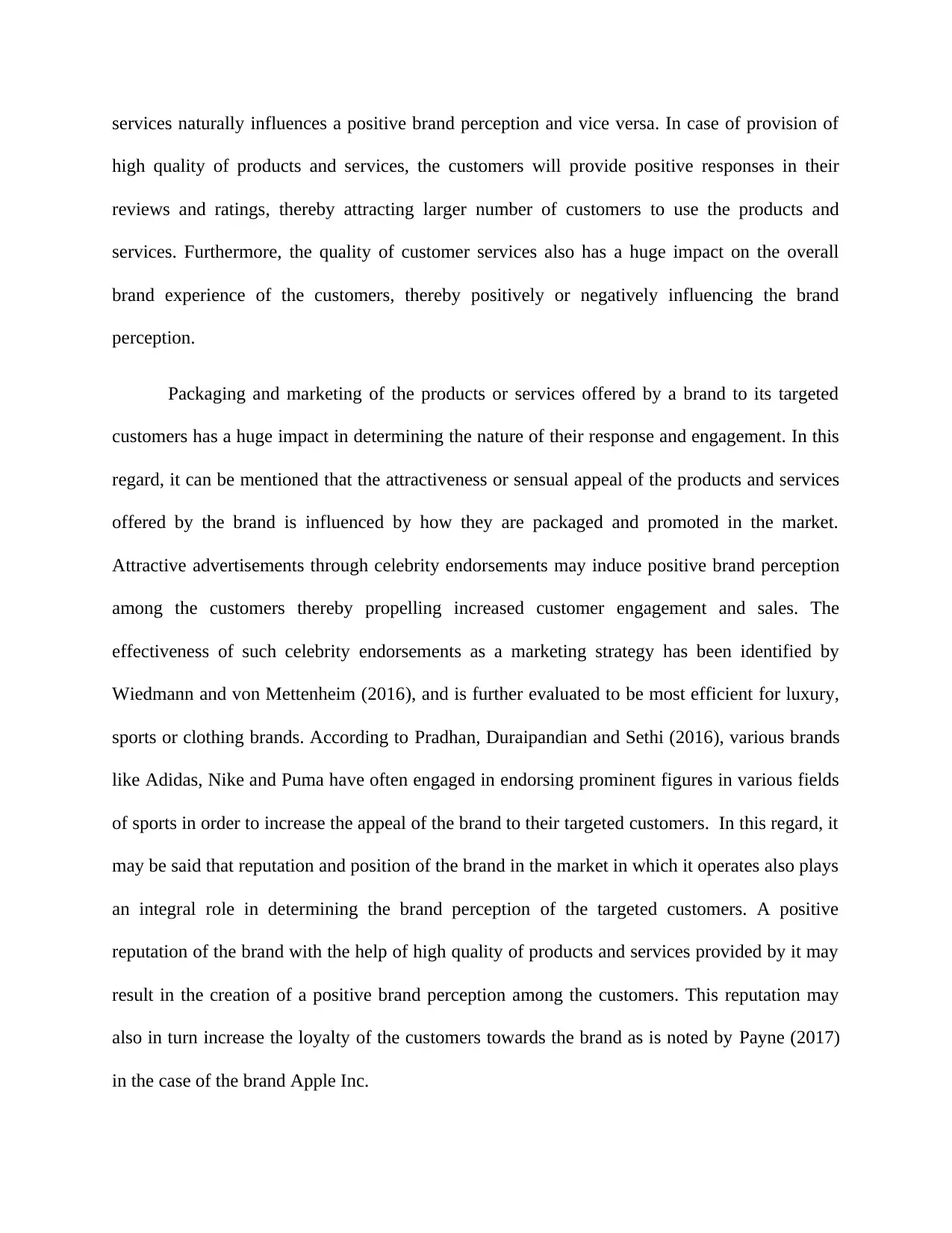
services naturally influences a positive brand perception and vice versa. In case of provision of
high quality of products and services, the customers will provide positive responses in their
reviews and ratings, thereby attracting larger number of customers to use the products and
services. Furthermore, the quality of customer services also has a huge impact on the overall
brand experience of the customers, thereby positively or negatively influencing the brand
perception.
Packaging and marketing of the products or services offered by a brand to its targeted
customers has a huge impact in determining the nature of their response and engagement. In this
regard, it can be mentioned that the attractiveness or sensual appeal of the products and services
offered by the brand is influenced by how they are packaged and promoted in the market.
Attractive advertisements through celebrity endorsements may induce positive brand perception
among the customers thereby propelling increased customer engagement and sales. The
effectiveness of such celebrity endorsements as a marketing strategy has been identified by
Wiedmann and von Mettenheim (2016), and is further evaluated to be most efficient for luxury,
sports or clothing brands. According to Pradhan, Duraipandian and Sethi (2016), various brands
like Adidas, Nike and Puma have often engaged in endorsing prominent figures in various fields
of sports in order to increase the appeal of the brand to their targeted customers. In this regard, it
may be said that reputation and position of the brand in the market in which it operates also plays
an integral role in determining the brand perception of the targeted customers. A positive
reputation of the brand with the help of high quality of products and services provided by it may
result in the creation of a positive brand perception among the customers. This reputation may
also in turn increase the loyalty of the customers towards the brand as is noted by Payne (2017)
in the case of the brand Apple Inc.
high quality of products and services, the customers will provide positive responses in their
reviews and ratings, thereby attracting larger number of customers to use the products and
services. Furthermore, the quality of customer services also has a huge impact on the overall
brand experience of the customers, thereby positively or negatively influencing the brand
perception.
Packaging and marketing of the products or services offered by a brand to its targeted
customers has a huge impact in determining the nature of their response and engagement. In this
regard, it can be mentioned that the attractiveness or sensual appeal of the products and services
offered by the brand is influenced by how they are packaged and promoted in the market.
Attractive advertisements through celebrity endorsements may induce positive brand perception
among the customers thereby propelling increased customer engagement and sales. The
effectiveness of such celebrity endorsements as a marketing strategy has been identified by
Wiedmann and von Mettenheim (2016), and is further evaluated to be most efficient for luxury,
sports or clothing brands. According to Pradhan, Duraipandian and Sethi (2016), various brands
like Adidas, Nike and Puma have often engaged in endorsing prominent figures in various fields
of sports in order to increase the appeal of the brand to their targeted customers. In this regard, it
may be said that reputation and position of the brand in the market in which it operates also plays
an integral role in determining the brand perception of the targeted customers. A positive
reputation of the brand with the help of high quality of products and services provided by it may
result in the creation of a positive brand perception among the customers. This reputation may
also in turn increase the loyalty of the customers towards the brand as is noted by Payne (2017)
in the case of the brand Apple Inc.
⊘ This is a preview!⊘
Do you want full access?
Subscribe today to unlock all pages.

Trusted by 1+ million students worldwide
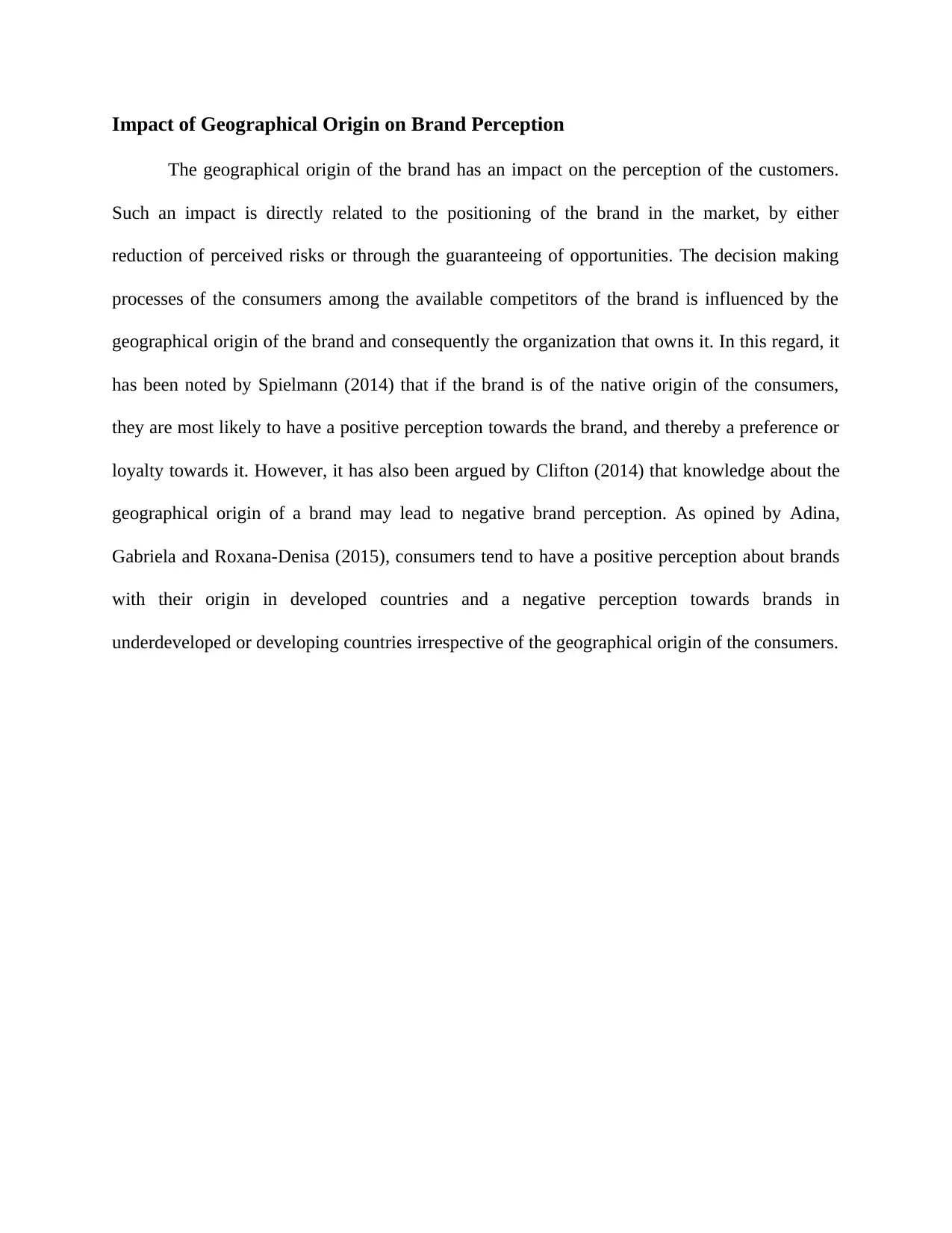
Impact of Geographical Origin on Brand Perception
The geographical origin of the brand has an impact on the perception of the customers.
Such an impact is directly related to the positioning of the brand in the market, by either
reduction of perceived risks or through the guaranteeing of opportunities. The decision making
processes of the consumers among the available competitors of the brand is influenced by the
geographical origin of the brand and consequently the organization that owns it. In this regard, it
has been noted by Spielmann (2014) that if the brand is of the native origin of the consumers,
they are most likely to have a positive perception towards the brand, and thereby a preference or
loyalty towards it. However, it has also been argued by Clifton (2014) that knowledge about the
geographical origin of a brand may lead to negative brand perception. As opined by Adina,
Gabriela and Roxana-Denisa (2015), consumers tend to have a positive perception about brands
with their origin in developed countries and a negative perception towards brands in
underdeveloped or developing countries irrespective of the geographical origin of the consumers.
The geographical origin of the brand has an impact on the perception of the customers.
Such an impact is directly related to the positioning of the brand in the market, by either
reduction of perceived risks or through the guaranteeing of opportunities. The decision making
processes of the consumers among the available competitors of the brand is influenced by the
geographical origin of the brand and consequently the organization that owns it. In this regard, it
has been noted by Spielmann (2014) that if the brand is of the native origin of the consumers,
they are most likely to have a positive perception towards the brand, and thereby a preference or
loyalty towards it. However, it has also been argued by Clifton (2014) that knowledge about the
geographical origin of a brand may lead to negative brand perception. As opined by Adina,
Gabriela and Roxana-Denisa (2015), consumers tend to have a positive perception about brands
with their origin in developed countries and a negative perception towards brands in
underdeveloped or developing countries irrespective of the geographical origin of the consumers.
Paraphrase This Document
Need a fresh take? Get an instant paraphrase of this document with our AI Paraphraser
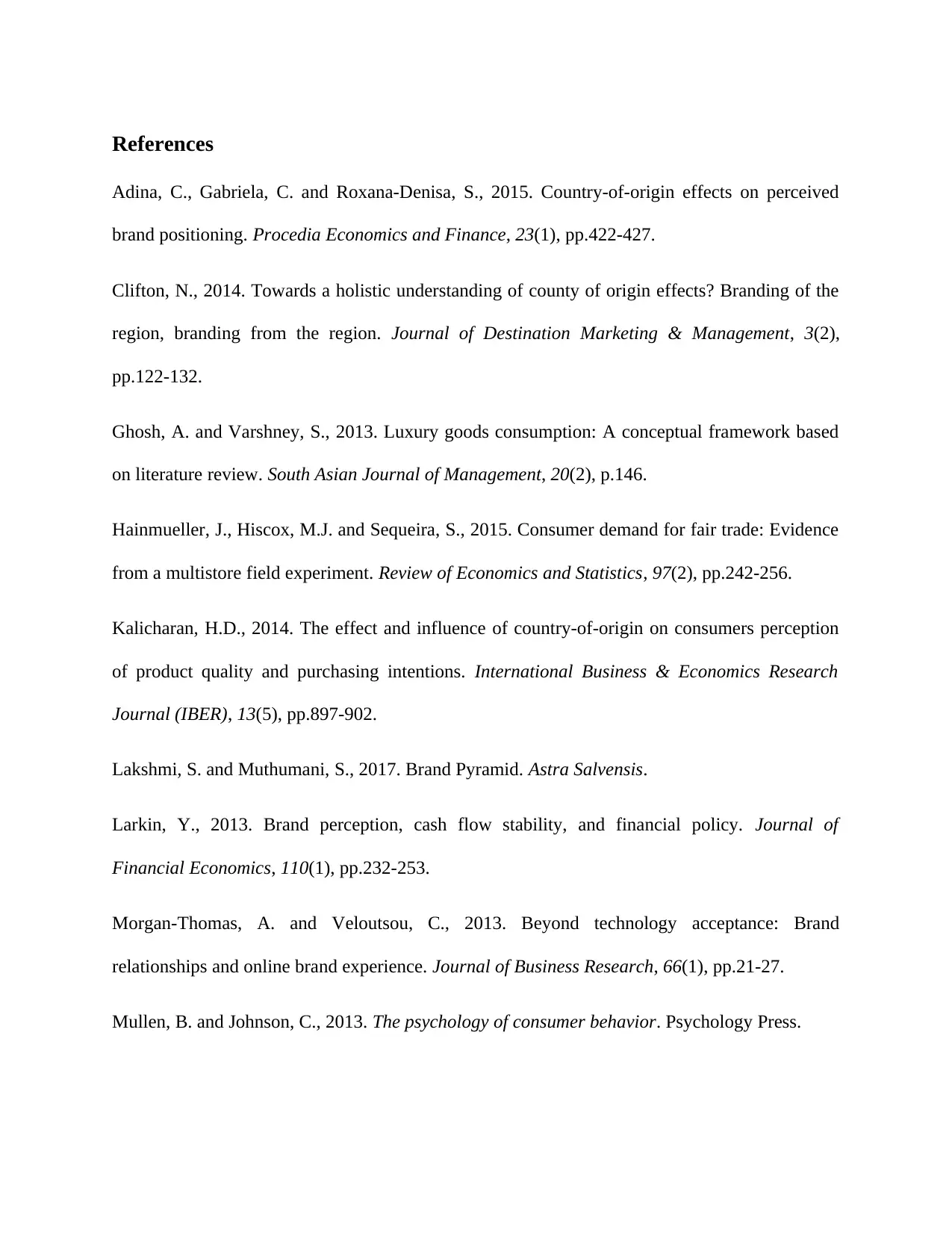
References
Adina, C., Gabriela, C. and Roxana-Denisa, S., 2015. Country-of-origin effects on perceived
brand positioning. Procedia Economics and Finance, 23(1), pp.422-427.
Clifton, N., 2014. Towards a holistic understanding of county of origin effects? Branding of the
region, branding from the region. Journal of Destination Marketing & Management, 3(2),
pp.122-132.
Ghosh, A. and Varshney, S., 2013. Luxury goods consumption: A conceptual framework based
on literature review. South Asian Journal of Management, 20(2), p.146.
Hainmueller, J., Hiscox, M.J. and Sequeira, S., 2015. Consumer demand for fair trade: Evidence
from a multistore field experiment. Review of Economics and Statistics, 97(2), pp.242-256.
Kalicharan, H.D., 2014. The effect and influence of country-of-origin on consumers perception
of product quality and purchasing intentions. International Business & Economics Research
Journal (IBER), 13(5), pp.897-902.
Lakshmi, S. and Muthumani, S., 2017. Brand Pyramid. Astra Salvensis.
Larkin, Y., 2013. Brand perception, cash flow stability, and financial policy. Journal of
Financial Economics, 110(1), pp.232-253.
Morgan-Thomas, A. and Veloutsou, C., 2013. Beyond technology acceptance: Brand
relationships and online brand experience. Journal of Business Research, 66(1), pp.21-27.
Mullen, B. and Johnson, C., 2013. The psychology of consumer behavior. Psychology Press.
Adina, C., Gabriela, C. and Roxana-Denisa, S., 2015. Country-of-origin effects on perceived
brand positioning. Procedia Economics and Finance, 23(1), pp.422-427.
Clifton, N., 2014. Towards a holistic understanding of county of origin effects? Branding of the
region, branding from the region. Journal of Destination Marketing & Management, 3(2),
pp.122-132.
Ghosh, A. and Varshney, S., 2013. Luxury goods consumption: A conceptual framework based
on literature review. South Asian Journal of Management, 20(2), p.146.
Hainmueller, J., Hiscox, M.J. and Sequeira, S., 2015. Consumer demand for fair trade: Evidence
from a multistore field experiment. Review of Economics and Statistics, 97(2), pp.242-256.
Kalicharan, H.D., 2014. The effect and influence of country-of-origin on consumers perception
of product quality and purchasing intentions. International Business & Economics Research
Journal (IBER), 13(5), pp.897-902.
Lakshmi, S. and Muthumani, S., 2017. Brand Pyramid. Astra Salvensis.
Larkin, Y., 2013. Brand perception, cash flow stability, and financial policy. Journal of
Financial Economics, 110(1), pp.232-253.
Morgan-Thomas, A. and Veloutsou, C., 2013. Beyond technology acceptance: Brand
relationships and online brand experience. Journal of Business Research, 66(1), pp.21-27.
Mullen, B. and Johnson, C., 2013. The psychology of consumer behavior. Psychology Press.
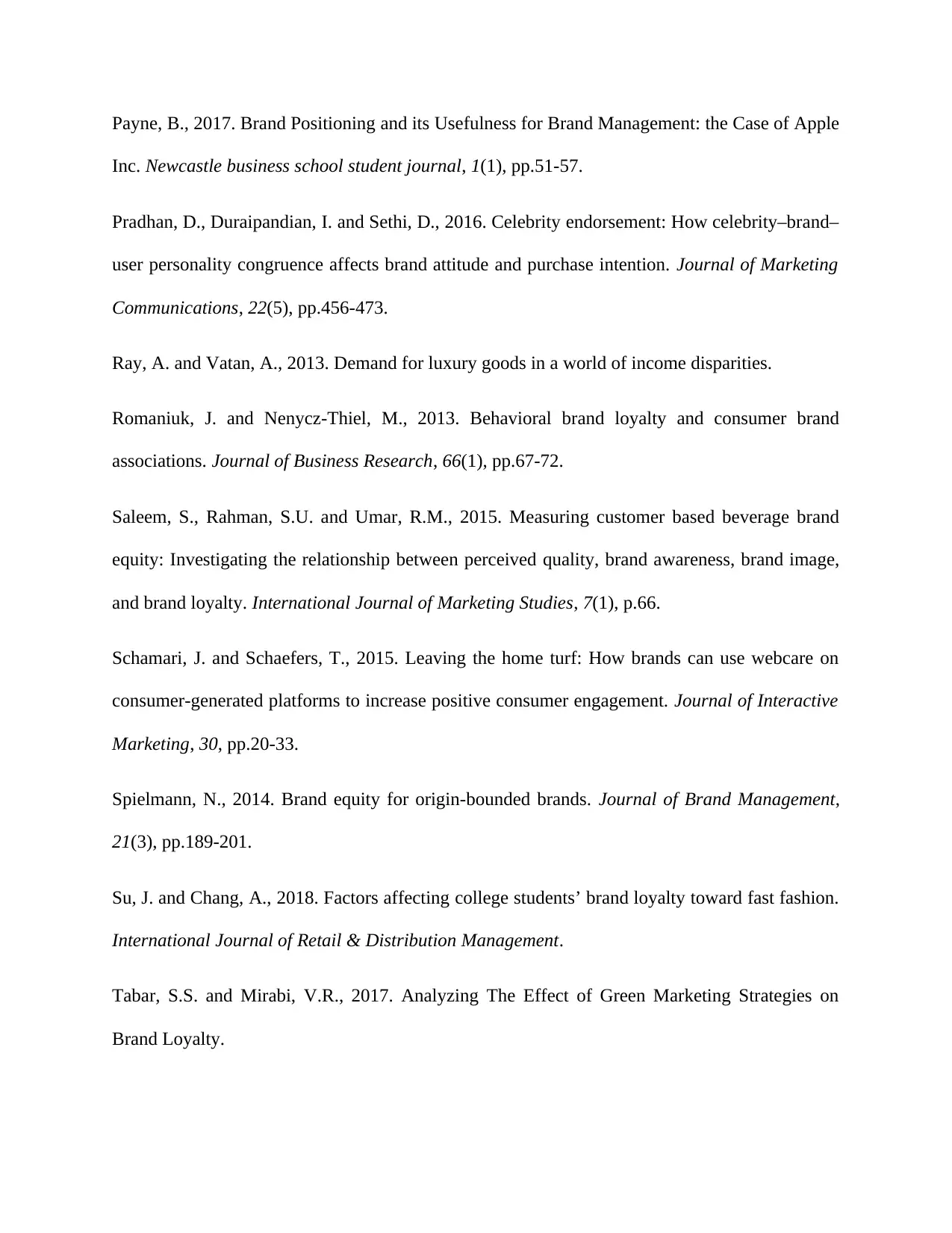
Payne, B., 2017. Brand Positioning and its Usefulness for Brand Management: the Case of Apple
Inc. Newcastle business school student journal, 1(1), pp.51-57.
Pradhan, D., Duraipandian, I. and Sethi, D., 2016. Celebrity endorsement: How celebrity–brand–
user personality congruence affects brand attitude and purchase intention. Journal of Marketing
Communications, 22(5), pp.456-473.
Ray, A. and Vatan, A., 2013. Demand for luxury goods in a world of income disparities.
Romaniuk, J. and Nenycz-Thiel, M., 2013. Behavioral brand loyalty and consumer brand
associations. Journal of Business Research, 66(1), pp.67-72.
Saleem, S., Rahman, S.U. and Umar, R.M., 2015. Measuring customer based beverage brand
equity: Investigating the relationship between perceived quality, brand awareness, brand image,
and brand loyalty. International Journal of Marketing Studies, 7(1), p.66.
Schamari, J. and Schaefers, T., 2015. Leaving the home turf: How brands can use webcare on
consumer-generated platforms to increase positive consumer engagement. Journal of Interactive
Marketing, 30, pp.20-33.
Spielmann, N., 2014. Brand equity for origin-bounded brands. Journal of Brand Management,
21(3), pp.189-201.
Su, J. and Chang, A., 2018. Factors affecting college students’ brand loyalty toward fast fashion.
International Journal of Retail & Distribution Management.
Tabar, S.S. and Mirabi, V.R., 2017. Analyzing The Effect of Green Marketing Strategies on
Brand Loyalty.
Inc. Newcastle business school student journal, 1(1), pp.51-57.
Pradhan, D., Duraipandian, I. and Sethi, D., 2016. Celebrity endorsement: How celebrity–brand–
user personality congruence affects brand attitude and purchase intention. Journal of Marketing
Communications, 22(5), pp.456-473.
Ray, A. and Vatan, A., 2013. Demand for luxury goods in a world of income disparities.
Romaniuk, J. and Nenycz-Thiel, M., 2013. Behavioral brand loyalty and consumer brand
associations. Journal of Business Research, 66(1), pp.67-72.
Saleem, S., Rahman, S.U. and Umar, R.M., 2015. Measuring customer based beverage brand
equity: Investigating the relationship between perceived quality, brand awareness, brand image,
and brand loyalty. International Journal of Marketing Studies, 7(1), p.66.
Schamari, J. and Schaefers, T., 2015. Leaving the home turf: How brands can use webcare on
consumer-generated platforms to increase positive consumer engagement. Journal of Interactive
Marketing, 30, pp.20-33.
Spielmann, N., 2014. Brand equity for origin-bounded brands. Journal of Brand Management,
21(3), pp.189-201.
Su, J. and Chang, A., 2018. Factors affecting college students’ brand loyalty toward fast fashion.
International Journal of Retail & Distribution Management.
Tabar, S.S. and Mirabi, V.R., 2017. Analyzing The Effect of Green Marketing Strategies on
Brand Loyalty.
⊘ This is a preview!⊘
Do you want full access?
Subscribe today to unlock all pages.

Trusted by 1+ million students worldwide
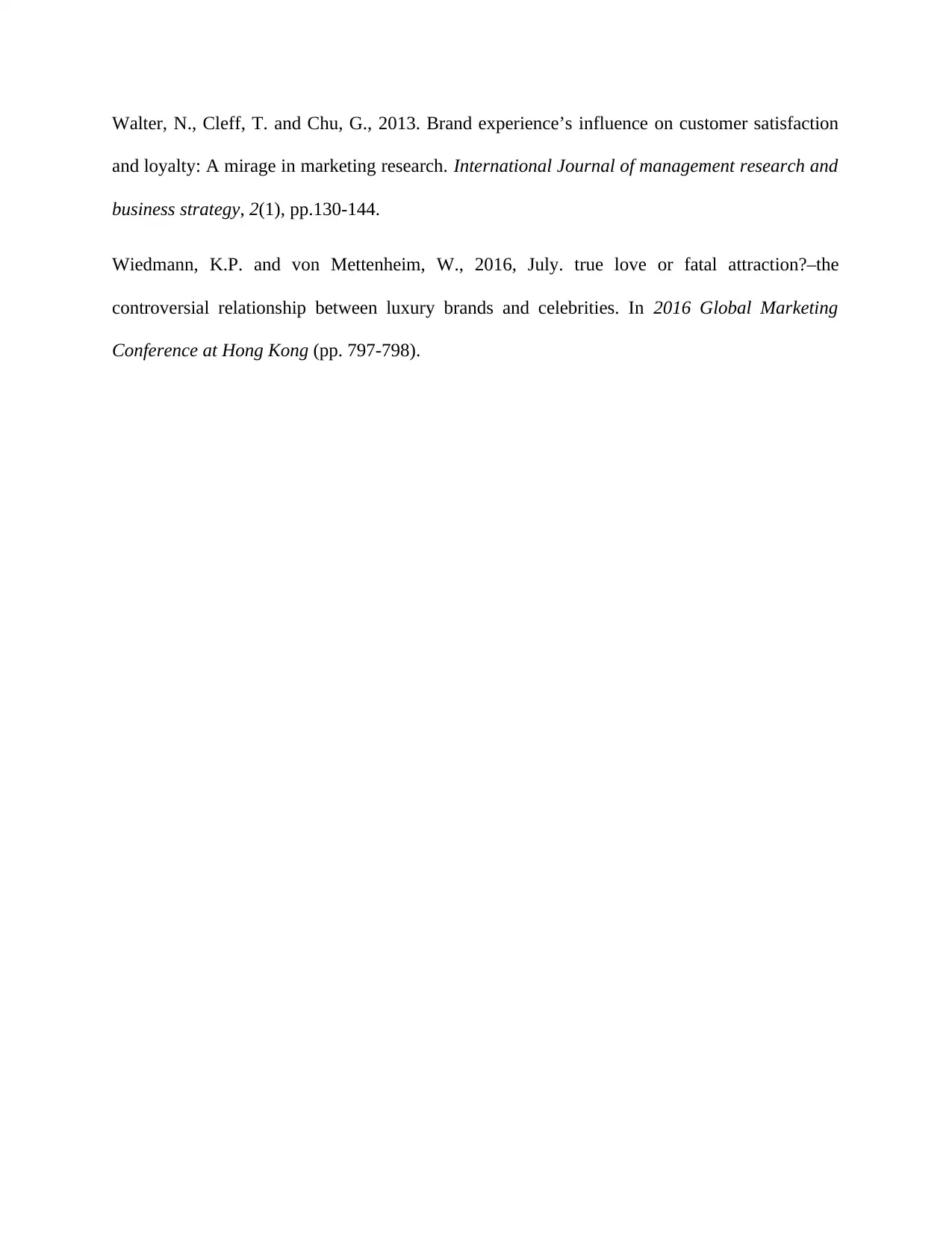
Walter, N., Cleff, T. and Chu, G., 2013. Brand experience’s influence on customer satisfaction
and loyalty: A mirage in marketing research. International Journal of management research and
business strategy, 2(1), pp.130-144.
Wiedmann, K.P. and von Mettenheim, W., 2016, July. true love or fatal attraction?–the
controversial relationship between luxury brands and celebrities. In 2016 Global Marketing
Conference at Hong Kong (pp. 797-798).
and loyalty: A mirage in marketing research. International Journal of management research and
business strategy, 2(1), pp.130-144.
Wiedmann, K.P. and von Mettenheim, W., 2016, July. true love or fatal attraction?–the
controversial relationship between luxury brands and celebrities. In 2016 Global Marketing
Conference at Hong Kong (pp. 797-798).
1 out of 10
Related Documents
Your All-in-One AI-Powered Toolkit for Academic Success.
+13062052269
info@desklib.com
Available 24*7 on WhatsApp / Email
![[object Object]](/_next/static/media/star-bottom.7253800d.svg)
Unlock your academic potential
Copyright © 2020–2025 A2Z Services. All Rights Reserved. Developed and managed by ZUCOL.




